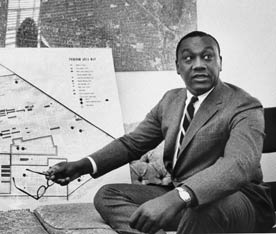The community-development field currently faces fundamental questions about its ongoing role. Many voices in the world of foundations and intermediaries (organizations that operate between policymakers and practitioners to facilitate the work) call for community-development groups to “go to scale,” equating growth with efficacy. (See Balancing Act by Dee Walsh and Robert Zdenek) Recent initiatives by the Fannie Mae and McArthur foundations and others have sought to strengthen large producers of affordable housing to the exclusion of neighborhood-based organizations. Public support for community development corporations as community developers as opposed to affordable-housing developers seems harder and harder to come by. In my own state of Massachusetts, for example, a state program that supported community development, broadly defined, for two decades, nurturing the growth of community development corporations, died about five years ago. It has been partially replaced by a program focused on increasing the capacity of nonprofits to produce affordable housing. Community development corporations in rural western Massachusetts that have emphasized growing local businesses lost funding, and the focus of other organizations narrowed. Banks, corporations, foundations, and public officials seek “efficiency” in our sector, which they often define in terms of bigger organizations on a larger geographic scale. We are certainly subject to the same impetus to growth that animates the whole society, as McKibben makes clear.
With his emphasis on the importance of local economies in building community, McKibben points the way to another path for the future of the community-development movement. Community development corporations are, despite mergers and growth, by and large local, accessible institutions. Many of the things that community development corporations already do nurture and support local economic activity, from micro-business technical assistance to revitalizing neighborhood commercial areas to rehabilitating housing in existing communities. Community development organizations like the Lower Cape Cod Development Corporation and the Franklin County Community Development Corporation in Greenfield, Massachusetts have worked to develop local businesses such as The People’s Pint in Greenfield, a brew pub that brews beer made from local grain. Other community development organizations such as Viet Aid in Boston have begun a cooperative cleaning company that cleans with green products.
Community development corporations as geographically based organizations are also a place where local political action can be nurtured to support a different version of the future. My own organization, the Allston Brighton CDC, has advocated transit and open space improvements so that our neighbor Harvard does not simply build a green building or a green campus but helps us build a green community. If the economic future that McKibben points toward is going to happen it will of necessity be accompanied by changes in the allocation of public resources.
Community development corporations and other community economic development enterprises seem uniquely positioned to serve as catalysts and advocates for the kind of future that McKibben argues for. We can and are integrating a vision of a community that is both environmentally and socially “durable,” to use McKibben’s term. It means that the emphasis placed on green building in the affordable-housing field over the past several years needs to be expanded toward an emphasis on building communities that minimize our reliance on fossil fuels, communities where more of the food people eat is locally produced, where one need not own a car, where the public open spaces take precedence over private luxury, and where social and economic inequality is substantially reduced.
Many of us became organizers and developers because we placed a high value on community. McKibben makes a convincing case for the urgency of moving our society toward the same hierarchy of values. If community development organizations embrace his vision, then they may choose to deepen their work in one local community rather than become large-scale regional housing developers. My own organization has developed a strong capacity in homeownership education, financial literacy, and managing individual development accounts, and our programs serve a broader constituency than the 70,000 residents of our Boston neighborhood. Yet we remain locally focused in our housing development and community-organizing and planning work.
If “going to scale” means that our organizations are not accessible, human-scale institutions that can effectively serve as catalysts for local communities, then perhaps “going to scale” is a Faustian bargain that we should not accept. The economic realities of maintaining an organization, however, push all of us toward some kinds of growth, so the challenge may be in balancing a special service or product that does go to scale with the local geographic focus that McKibben reminds us is essential to fostering community.




Comments